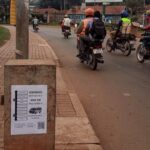Posts tagged with 'mobility'
Istanbul’s Caferağa neighborhood has a longstanding reputation for its cultural richness and historic charm. Quaint cafes, restaurants and bars line the sidewalks. A thriving arts scene draws an eclectic crowd. More than 2.3 million visitors daily flock to the district ...

In cities around the world, people are embracing electric buses, which provide a quieter, smoother ride without the harmful pollution from traditional gas and diesel buses. For example, bus riders in Pune, India, will skip boarding a diesel bus to wait for an electric ...

IT professional Nagarjun Kandukuru, 51, looks out of the window of his Bannerghatta Road home in Bengaluru and watches as his 16-year-old son cycles off to music class. The family has never owned a car. Kandukuru, himself, uses a motorcycle ...

Transforming Transportation 2025 is in the books. After a year of geopolitical turmoil and escalating climate impacts, the transport sector is seeing rapid change on multiple fronts. Across two days of events, leaders in government, business, academia and civil society ...

Transport is one of the fastest-growing sources of greenhouse gas emissions, accounting for 24% of carbon emissions worldwide. Nearly three-quarters of those emissions come from road vehicles. Solutions like electrification and increased public transport can reduce the transport sector’s emissions, but they ...

2024 was tumultuous. Cities saw record-breaking temperatures, a sharp uptick in climate-related disasters, violent conflict in too many places, and contentious elections that shifted local, national and regional politics. But amidst the tumult, cities centered themselves as global leaders in ...

2024 has been a tumultuous year: More than half the world’s population went to the ballot box — some voting for radical change — extraordinary weather events have devastated communities and countries have been rocked by continued violent conflict. Given ...

Livability is key to the quality of city life as we look to the future. We don’t have to look far into that future to see how this plays out on the streets. On Sunday, December 15, 1974, a group ...

Cities are home to more than half the world’s population: 4.4 billion people commuting, working, eating, shopping, and using light, heat and air conditioning. As a result, cities collectively produce over 70% of the greenhouse gas (GHG) emissions warming the planet. They ...

In the face of rapid urbanization, evolving mobility patterns and the looming climate crisis, the Sustainable Cities Challenge emerges as a pioneering initiative providing a catalytic approach to drive progress. Launched by the Toyota Mobility Foundation in collaboration with WRI ...

In December 2023, the floods in Chennai and neighboring districts of Tamil Nadu wreaked havoc on the lives and livelihoods of thousands of people. However, Tamil Nadu is not the only state to be impacted by the rising hazards of ...

Do informal transport networks in African cities provide equitable services for everyone that needs them? Unsurprisingly, the answer is often no. Operators frequently prefer to drive the safest and most central routes, inadvertently prioritizing commuters traveling to formal jobs in ...

On a Sunday afternoon in September 2023, a group of about 30 individuals, including a group of mostly female neighbors from nine kampungs (a common term for “urban villages” or “informal settlements” across multiple languages and nations in Southeast Asia) ...

Mexico became the first nation to declare access to safe mobility a human right in 2020 and two years later passed the General Law of Mobility and Road Safety to protect people, reduce collisions and promote sustainable modes of travel. Now, with this new ...

By early 2025, countries are due to unveil new national climate commitments under the Paris Agreement, known as nationally determined contributions (NDCs). These commitments form the foundation of international climate action, establishing emissions-reduction targets and other measures that countries promise ...




























